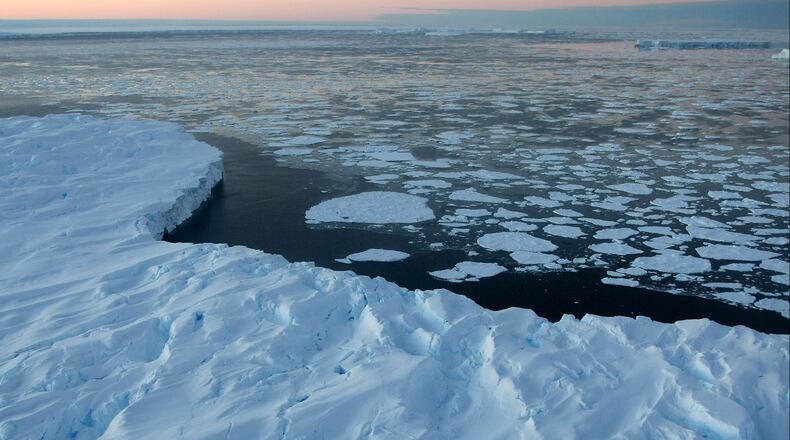The ice deep below eight of Antarctica's largest glaciers is melting at an alarming rate, a new scientific analysis has revealed.
According to the study, which was published this month in the academic journal Nature Geoscience, Antarctica's frozen underbelly is melting and receding at a rate around five times faster than normal. In the centuries following an ice age, glacier grounding lines should retreat about 82 feet per year. But the ice under Antarctica is retreating at speeds peaking around 600 feet annually.
» RELATED: Climate change is turning nearly all of these baby sea turtles female — Here's why
Between 2010 and 2016, researchers discovered that warming ocean temperatures had melted away approximately 565 square miles of the southernmost continent's underwater ice. That's roughly the size of London, England.
Scientists focus a lot of attention on melting ice in Antarctica because it can have a major impact on rising sea levels, Justin C. Burton, assistant professor at Emory University's department of physics, said. If all of Antarctica's ice were to melt, this would raise sea levels by 200 feet.
"If greenhouse gas emissions aren't controlled, then many models show that a significant portion of the Antarctic ice sheets will eventually melt, especially Western Antarctica," Burton said, adding that even if it took centuries for all of the ice to melt, the shorter-term implications of rising sea levels would still be a significant problem for humanity.
"A few meters of sea level rise in the near future would be devastating," he said. "This study shows that the retreat is very rapid in many areas of Antarctica, although some have stabilized."
For the new study, scientists from the Centre for Polar Observation and Modeling (CPOM) at the University of Leeds turned to satellite imagery and buoyancy equations to map out the "invisible retreat" of Antarctica's underwater ice. Their analysis focused on about 10,000 miles (or roughly one-third) of the continent's total perimeter.
>> Related: Climate change will internally displace 143 million people by 2050, scientists warn
"What's happening is that Antarctica is being melted away at its base. We can't see it, because it's happening below the sea surface," Professor Andrew Shepherd, one of the authors of the paper, told The Guardian. "The changes mean that very soon the sea-level contribution from Antarctica could outstrip that from Greenland."
Lead study author Hannes Konrad said in a statement that the data provides "clear evidence that retreat is happening across the ice sheet due to ocean melting at its base. This retreat has had a huge impact on inland glaciers, because releasing them from the seabed removes friction, causing them to speed up and contribute to global sea level rise."
"Now that we have mapped the whole edge of the ice sheet, it rules out any chance that parts of Antarctica are advancing. We see retreat in more places and stasis elsewhere. The net effect is that the ice sheet overall is retreating. People can't say 'you've left a stone unturned'. We've looked everywhere now," Shepherd said.
Burton sees this new study as an even stronger challenge to climate change skeptics.
>> Related: 15,000 scientists warn it will soon be 'too late' to save Earth
"It only solidifies our previous estimates of glacial retreat. For scientists, the current questions we face are not: 'is the climate changing,'" he said, pointing out that even major oil companies recognize that environmental changes are due to human influence.
"The questions we face now are 'how much' and 'how fast'. These are more difficult to answer, but previous estimates from decades ago seem to be accurate, and very worrisome," he said. "I think much of the skepticism today stems from a distrust of science itself. The skeptics aren't offering any type of scientific rebuttal. This is unfortunate, as climate change is perhaps the biggest problem humanity faces."
Beyond Antarctica's melting ice, a major scientific study published in December suggested that the worst-case predictions regarding the effects of global warming are the most likely to be true.
"Our study indicates that if emissions follow a commonly used business-as-usual scenario, there is a 93 percent chance that global warming will exceed 4°C by the end of this century," Dr. Ken Caldeira, an atmospheric scientist at the Carnegie Institution for Science, who co-authored the study, said at the time.
>> Related: Is chocolate really going extinct because of climate change?
Last year, more than 15,000 scientists from around the world signed an open letter warning that quick and drastic actions should be undertaken by society to address the threat of climate change.
"Soon it will be too late to shift course away from our failing trajectory, and time is running out," scientists wrote in the letter. "We must recognize, in our day-to-day lives and in our governing institutions, that Earth with all its life is our only home."
About the Author
Keep Reading
The Latest
Featured


